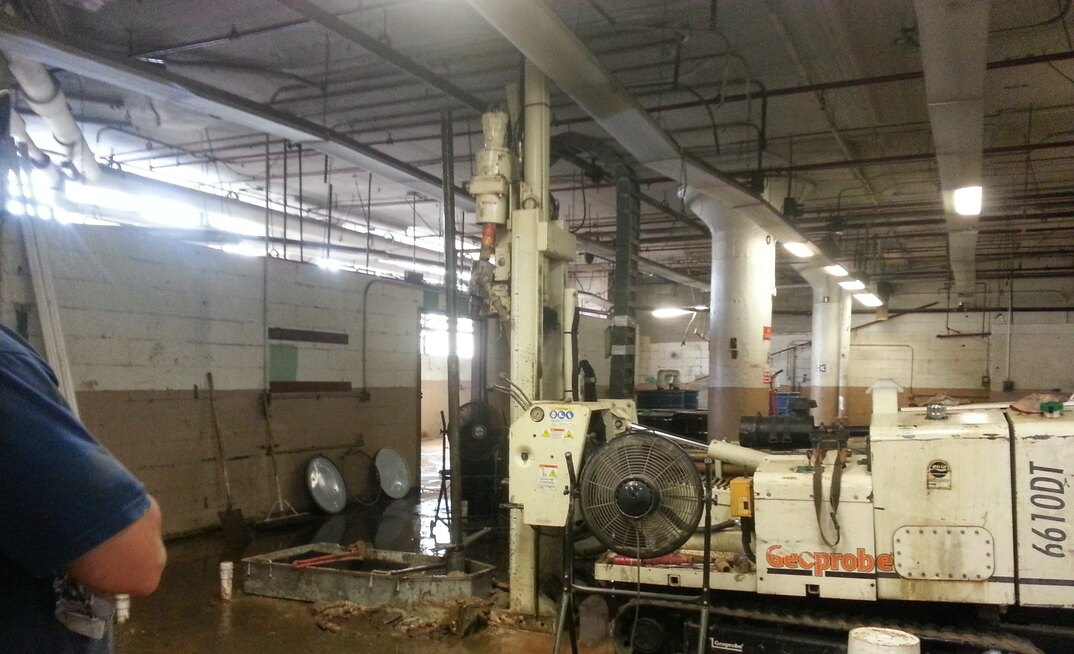If you have been in the drilling industry long enough to have a cup of coffee (or tea), you know that restricted access challenges are diverse and widespread. From urban project sites to marine settings, drillers face mobility constraints, spatial limitations, and environmental obstacles that require technological flexibility and operational creativity.
I'm going to take a look at three common challenges we encounter here at Aquifer Drilling & Testing (ADT), a Cascade Company, on our restricted access projects and the solutions we implement to overcome them. These techniques can also be employed throughout Cascade. Before we dive in, a note: while there is a distinction between the terms "restricted access," an area that's difficult to get equipment to, and "limited access," an area that limits the tools that can be used, there is enough overlap in how we approach problem-solving in these scenarios that we will explore both.
Challenge #1: overcoming access and mobility challenges in indoor environments
One of the most common challenges in restricted access drilling is navigating tight, constrained environments, particularly in urban settings, steep terrain, or confined spaces like basements or sub-basements. These environments pose significant operational hurdles, but ADT's experience and specialised equipment allow us to overcome them efficiently.
Take, for example, indoor drilling projects in basements or sub-basements. These areas often come with three primary concerns: access, ventilation, and temperature control. Without the proper equipment and a well-considered plan, setting up safely in these situations can be quite dangerous. Lack of proper ventilation when drilling indoors can lead to hazardous air quality and trapped heat, causing temperature fluctuations that may affect both personnel and equipment. To counteract this, ADT utilises high-efficiency particulate air (HEPA) filtration systems and strategically placed ventilation systems to maintain air quality and manage temperature in enclosed spaces.
YOU MIGHT ALSO LIKE
Additionally, limited overhead clearance, especially in urban settings or inside buildings, can prevent the use of standard drilling rigs. When clearance falls below 15ft, specialised, low-clearance drill rigs with short towers are employed. ADT's fleet includes compact rigs that are designed for such situations, allowing us to carry out site characterisation and geotechnical drilling in spaces where traditional equipment would not fit.
Challenge #2: Maximising efficiency in space-restricted urban drilling projects
These challenges are not limited to indoor environments - steep terrain or dense urban landscapes pose equally complex mobility issues.
This approach allows us to drill in difficult-to-reach areas
With limited room to manoeuvre, the challenge becomes maximising the space's efficiency while ensuring the project's safety and productivity. In these scenarios, ADT employs portable rigs and modular drilling setups that can be disassembled, transported and reassembled on-site.
This approach allows us to drill in difficult-to-reach areas while minimising disruption to surrounding operations or communities.
One of the most frequent issues we encounter is the need for a small geographic footprint. The available drill site is often constrained by surrounding infrastructure - such as buildings, roads, or utility lines - limiting the space for equipment and personnel. In these scenarios, ADT relies on compact drill rigs specifically designed for urban settings. These rigs are smaller, more agile, and can operate in tight spaces without sacrificing performance.
Working in crowded urban areas also requires careful logistical planning to ensure materials and personnel are efficiently coordinated. With years of experience navigating tight urban spaces, ADT's teams are adept at developing traffic control plans, coordinating with local authorities, and managing onsite operations with minimal impact on pedestrian and vehicular flow.
Challenge #3: The challenges of over water drilling in tidal zones
Drilling over water, in general, presents its own unique challenges, and this is especially true in tidal zones. The rise and fall of water levels at these locations makes these project sites inaccessible without specially designed marine vessels known as shallow draft lift boats. Not only do these specialised vessels offer a stable working platform, but they are capable of operating in areas with water depths as shallow as 3ft.

Timing is everything when working in tidal zones. To access the drill site, we strategically plan our operations around high tide, "sneaking in" when water levels are at their peak. Once on site, the lift boat deploys stabilising legs to secure the platform above the fluctuating water, allowing our team to carry out boring activities safely. This method not only ensures the safety of our crew but also prevents any equipment from becoming inappropriately stranded when the tide recedes.
Additionally, working in these environments often involves coordination with local marine regulations and environmental protection protocols to safeguard aquatic ecosystems. ADT's experience in navigating these regulations, combined with our use of environmentally sensitive equipment, ensures that our operations have minimal impact on surrounding waters and marine life.
Conclusion: Navigating the complexities of restricted access drilling
Restricted access challenges are a constant in the drilling industry, but they become opportunities for innovation and success with the right approach. At ADT, our expertise, combined with a versatile fleet of specialised equipment - including track and truck-mounted rigs for difficult-to-reach areas, low-clearance rigs for tight spaces, and marine vessels for over-water projects - enables us to overcome even the most demanding environments. By leveraging advanced technology and operational creativity, we ensure that no site is out of reach. With a focus on safety, efficiency, and environmental responsibility, we are committed to delivering.
Dan Spencer is the vice president of operations for Aquifer Drilling & Testing, a Cascade Company. He oversees environmental and geotechnical drilling projects in the greater New York City metropolitan area. ADT provides a full range of environmental and geotechnical drilling services with an extensive fleet of sonic and conventional drilling rigs and specialty equipment. Aquifer Drilling & Testing has been proud to serve the greater New York City area since 1989.



















